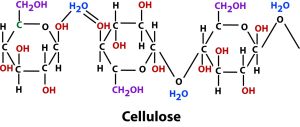Carbohydrates
Carbohydrates usually provide the majority of energy to goats. Carbohydrates can be classified as simple, such as sugars, or complex, such as starch found in grains, or cellulose, that is, fiber. Grass, forb and browse plant species generally contain high levels of cellulose, which must be digested by rumen bacteria to provide energy.

Cellulose is often referred to as fiber, although the term fiber also pertains to other substances such as hemicellulose and lignin. Fiber in young plants may be highly digestible and provide a high level of energy; but fiber in older, mature plants is often poorly digested and may provide only half the energy of other carbohydrates. Fiber in the diet may be characterized chemically in several ways, such as crude fiber (CF), acid detergent fiber (ADF) and neutral detergent fiber (NDF). These abbreviations are used in hay analysis and may appear on feed tags. In general, the lower the fiber level, the higher the level of digestible energy. However, a certain minimum fiber level is required for healthy rumen function.

Goats do not adapt as easily to high-concentrate diets as cattle and sheep and are more likely to get acidosis, founder, urinary calculi and enterotoxemia. To avoid these problems, very gradually increase the concentrate level in the diet when placing goats on high-concentrate diets and maintain a minimum of 12 percent crude fiber in the diet or about half of the diet as grass, browse or hay. Goats are typically not feed-efficient, except for some rapidly growing Boer goats, and may require 7 pounds or more of feed per pound of gain. Also, one must be very alert for health problems with goats on high-grain diets.
Reference: Hart, S. 2008. Meat Goat Nutrition. Pages 58-83 in Proc. 23rd Ann. Goat Field Day, Langston University, Langston, OK.
